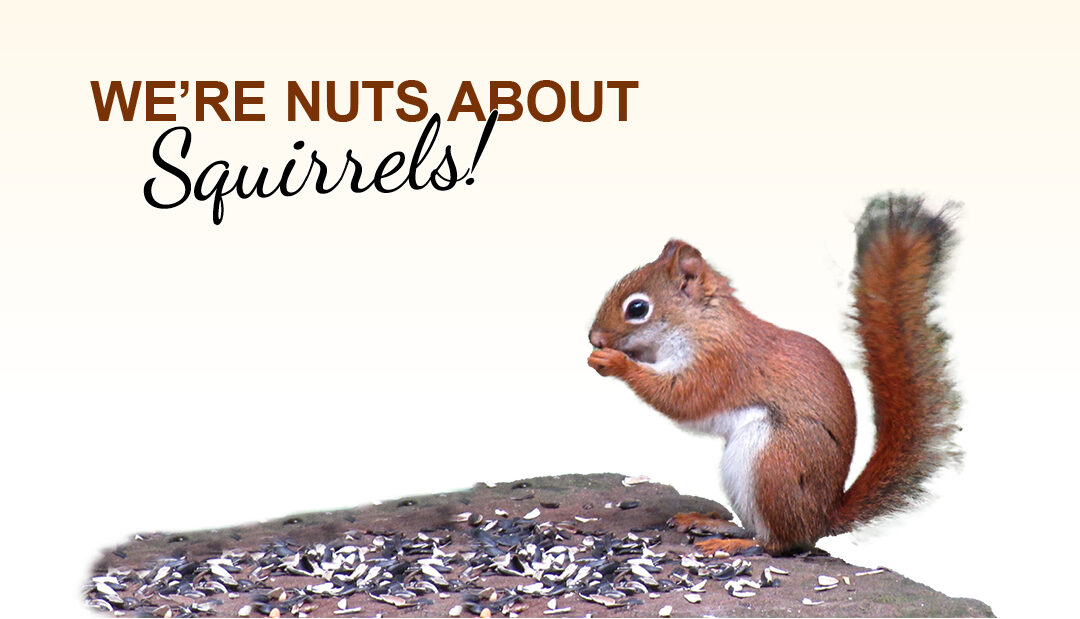Some people think of squirrels as bright-eyed bushy tailed critters scampering through the forest burying acorns. Other people think of squirrels as crafty acrobatic thieves raiding their backyard bird feeders. Whatever your opinion of them, squirrels provide a vital service to the forest ecology. The nuts they bury and forget to retrieve grow into new trees ensuring the regeneration of the forest.
At Sahli Nature Park, we have three kinds of squirrels, the Fox Squirrel, Gray Squirrel and Red Squirrel.
The Fox Squirrel, the largest of the three, is easily identified by its golden-brown belly. Its upper body fur is gray to reddish brown with a darker head and nose. Fox squirrels weigh about 2 pounds and are about 21 inches long including a 10-inch tail.
Gray squirrels are the most common type of squirrel in Pennsylvania. Most grays are silvery gray with an off-white belly, chin, and throat, and sometimes have reddish or brownish markings on their sides or tails. They also have white rings around their eyes. Grays weigh about 1-1 1⁄2 pounds and are about 18 – 20 inches long.
The smallest of the three, the Red Squirrel, is very vocal and active. Its fur is a rusty reddish brown with a white belly and a white eye ring. During the winter, red squirrels grow tufts of fur on the tips of their ears. Reds weigh only about 5 ounces and are just about 12 inches long.
Squirrels live in nests or dens. High in the treetops, 40- 60 feet above the ground, they build nests of leaves, twigs, grass, bark, roots, and other plant materials on a framework of twigs with an opening facing the tree trunk. Lined with moss, grass, and shredded bark, the rounded nests are about 12 to 20 inches in diameter. Dens are in tree cavities where branches have broken off or in woodpecker holes. When using tree cavities, squirrels will gnaw larger entrance holes and make an inside chamber which they line with leaves and grass.
Squirrels eat a variety of things, not just acorns. They eat hickory nuts, walnuts, beechnuts, hazelnuts, berries, mushrooms, pine seeds, corn, flowers, insects, and the fruits from dogwood, wild cherry, witch hazel, poplar and black gum trees. In the spring, squirrels eat buds which provide a good source of energy. They especially enjoy the buds, flowers, and winged seeds of red maples. Red squirrels particularly enjoy seeds found in the cones of white pines and hemlocks. Fox squirrels will also eat birds’ eggs and even young birds. Gray squirrels are not territorial and often feed together in groups. During the autumn, squirrels store food for the coming winter. Grays and Fox Squirrels bury nuts one at a time, but Reds hide their food in large piles often inside a hollow log, on stumps, or underground. Reds actively defend their food supply from any intruders. A keen sense of smell and a good memory help squirrels find the nuts they have buried. Nuts that are not eaten often grow into new trees, replenishing the forest habitat.
Squirrels are fast and agile. When jumping from tree to tree, they use their long tails for balance and as a sort of parachute. Although they only see in shades of black and white, their vision is sharp, and they see movement well. Squirrels have great senses of smell and hearing. During the winter, they do not hibernate. They spend the cold snowy days sleeping in their nests or dens and come out to search for food. Their natural predators include hawks, owls, foxes, raccoons, and tree climbing snakes which prey upon young squirrels and nestlings. Domestic cats, cars, and electrical wires are also the causes of death for many squirrels.
The next time you visit Sahli Nature Park you may see or hear spruce cones dropping from the trees. The squirrels climb out onto the branches and chew through the stems of the cones which then drop to the ground. When there are plenty of cones on the ground, the squirrels climb down to feed on them. Sometimes it seems like it’s raining spruce cones!







